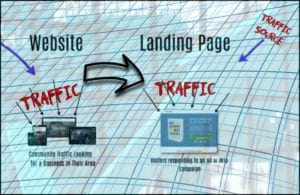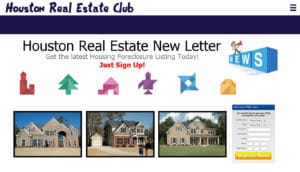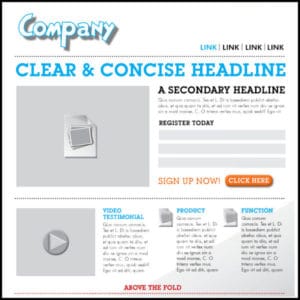Are you struggling to convert website visitors into leads or customers? If so, building landing pages that convert can help you achieve your marketing goals. Landing pages are standalone web pages that are designed to convert visitors into leads or customers by offering them a specific offer or message. While a homepage is designed to provide general information about your business, a landing page is focused on a specific goal, such as signing up for a newsletter or purchasing a product. In this article, we’ll cover the basics of building landing pages that convert using WordPress, as well as other popular platforms like Systeme.IO and ClickFunnels. We’ll explore the different types of landing pages, their benefits, and how to create them effectively to achieve your marketing goals. So, let’s dive in!
What is a Landing Page?
 In the digital world, a landing page is a dedicated website created specifically for marketing or advertising campaigns. When a user clicks on a link from a search engine or a Google ad, they “land” on this page. Unlike other website pages, landing pages have a single focused objective – to encourage visitors to take a specific action, known as a Call to Action (CTA). This action could be anything from subscribing to a newsletter to taking advantage of a sale or downloading a free resource. The simplicity of landing pages makes them an excellent choice for increasing conversion rates and reducing the cost of acquiring sales leads. To better understand the distinction between a landing page, homepage, and squeeze page, it’s important to clearly define each.
In the digital world, a landing page is a dedicated website created specifically for marketing or advertising campaigns. When a user clicks on a link from a search engine or a Google ad, they “land” on this page. Unlike other website pages, landing pages have a single focused objective – to encourage visitors to take a specific action, known as a Call to Action (CTA). This action could be anything from subscribing to a newsletter to taking advantage of a sale or downloading a free resource. The simplicity of landing pages makes them an excellent choice for increasing conversion rates and reducing the cost of acquiring sales leads. To better understand the distinction between a landing page, homepage, and squeeze page, it’s important to clearly define each.
Landing Page vs Homepage: Understanding the Difference
Your website’s homepage serves as the storefront of your online business. It provides an overview of your brand, your products, and your services. On the other hand, a landing page is more like a booth at a trade show. It’s designed to captivate and persuade visitors to take a specific action, such as signing up for a newsletter, filling out a form, or making a purchase. Unlike a homepage, a landing page has a singular focus, with the goal of driving conversions and achieving a specific business objective.
Landing Pages vs Squeeze Pages: Understanding the Difference
When it comes to online marketing, landing pages, and squeeze pages are often used interchangeably, but they serve different purposes. While a landing page is designed to provide information about a product or service and persuade visitors to take a specific action, a squeeze page’s primary objective is to collect the prospect’s email address or other contact information. Squeeze pages are often used to offer something in exchange for contact information, such as a free ebook or access to a private podcast. Although there are similarities between the two, squeeze pages require a more streamlined approach and typically focus on a single offer. In this post, we’ll use the terms landing pages and squeeze pages interchangeably and explore their methods and purposes.
Landing Pages: Benefits and Best Practices
 Landing pages are an essential component of any successful online marketing campaign. A landing page is the first page that a user is directed to after clicking on an online advertisement or search engine result. It serves as a crucial factor in determining whether a customer will make a purchase or take any other desired action. A landing page typically contains directed sales copy and is designed to be a logical extension of the advertisement that the user clicked on. By directing users to a landing page that speaks directly to their interests, businesses can significantly increase their chances of converting leads into customers. In this post, we will explore the benefits of landing pages, including the importance of tailoring content to users’ interests, the role of clear call-to-actions, and the best practices for creating effective landing pages that drive conversions.
Landing pages are an essential component of any successful online marketing campaign. A landing page is the first page that a user is directed to after clicking on an online advertisement or search engine result. It serves as a crucial factor in determining whether a customer will make a purchase or take any other desired action. A landing page typically contains directed sales copy and is designed to be a logical extension of the advertisement that the user clicked on. By directing users to a landing page that speaks directly to their interests, businesses can significantly increase their chances of converting leads into customers. In this post, we will explore the benefits of landing pages, including the importance of tailoring content to users’ interests, the role of clear call-to-actions, and the best practices for creating effective landing pages that drive conversions.
Landing Pages: Types and Their Importance in Conversions
If you’re familiar with digital marketing, you’ve probably heard of landing pages. But what exactly are they? In simple terms, a landing page is a web page designed to convert visitors into leads or customers. But there’s more to it than that.
There are several types of landing pages, and each serves a different purpose. For instance, a homepage is not the same as a landing page. While a homepage provides a general overview of your business, a landing page is designed to target a specific audience and prompt them to take action.
Another type of landing page is a squeeze page. A squeeze page is a type of landing page designed to capture a visitor’s email address or other contact information. This can be used for email marketing campaigns and other forms of lead generation.
The content on a landing page can vary depending on the goal of the page. Some landing pages feature a product or service with a call-to-action to purchase or sign up. Others may offer a free trial or consultation to entice the visitor to take action.
In short, landing pages are a crucial element in any digital marketing campaign. By understanding the different types of landing pages and their purposes, you can create effective pages that drive conversions and help grow your business.
Understanding Landing Pages: What is a Reference Landing Page?
 A reference landing page is a type of landing page that provides information that a visitor is interested in. These pages are designed to display information about a specific subject, often in response to a search query, and are presented in the form of text, images, and relevant links. For example, if you search for a cell phone in your browser and click on a link, the resulting reference landing page will typically include images of cell phones, informative text about cell phones, and related links to other relevant resources. Reference landing pages are a useful tool for providing visitors with targeted, relevant information that can help them make informed decisions.
A reference landing page is a type of landing page that provides information that a visitor is interested in. These pages are designed to display information about a specific subject, often in response to a search query, and are presented in the form of text, images, and relevant links. For example, if you search for a cell phone in your browser and click on a link, the resulting reference landing page will typically include images of cell phones, informative text about cell phones, and related links to other relevant resources. Reference landing pages are a useful tool for providing visitors with targeted, relevant information that can help them make informed decisions.
Transactional Landing Pages: Persuading Visitors to Take Action
 When it comes to online marketing, transactional landing pages play a vital role in persuading visitors to take action. The primary purpose of these pages is to convert visitors into customers by encouraging them to complete a specific action, such as filling out a form, subscribing to a mailing list, making a purchase, or joining a membership. In other words, transactional landing pages are designed to obtain as much information from visitors as possible and turn them into paying customers. With a well-crafted transactional landing page, businesses can increase their conversion rates and achieve their marketing goals more effectively.
When it comes to online marketing, transactional landing pages play a vital role in persuading visitors to take action. The primary purpose of these pages is to convert visitors into customers by encouraging them to complete a specific action, such as filling out a form, subscribing to a mailing list, making a purchase, or joining a membership. In other words, transactional landing pages are designed to obtain as much information from visitors as possible and turn them into paying customers. With a well-crafted transactional landing page, businesses can increase their conversion rates and achieve their marketing goals more effectively.
Why Landing Pages are Crucial for Your Business
The saying, “The first impression is the last impression” holds true in the world of business. As a result, companies invest a significant amount of time, money, and resources into making their products or services as appealing as possible. However, many organizations fail to apply the same principle to their online presence, particularly their website, and often question the importance of landing pages.
In today’s digital world, having a well-designed landing page is essential for any business. A landing page is a stand-alone web page designed to persuade visitors to take a specific action, such as filling out a form or making a purchase. Here’s why landing pages are crucial for your business:
-
Boosts Conversion Rates: A landing page is designed with a specific purpose in mind and is optimized to convert visitors into leads or customers. By providing targeted information and a clear call-to-action, a landing page can significantly boost your conversion rates.
-
Provides a Better User Experience: Unlike a cluttered homepage, a landing page is designed with simplicity and clarity in mind. It provides a better user experience by focusing on a specific product or service and eliminating distractions.
-
Improves Search Engine Optimization: A well-designed landing page can improve your search engine optimization (SEO) efforts by providing relevant content and keywords. This can help your website rank higher in search engine results pages, increasing your visibility to potential customers.
-
Increases Advertising ROI: By using landing pages in your advertising campaigns, you can increase your return on investment (ROI) by providing a targeted message and improving the relevance of your ads.
Whether you are using WordPress, Systeme.IO, or Click Funnels, creating effective landing pages is crucial for your business. By understanding the importance of landing pages, you can improve your online presence, attract more customers, and increase your revenue.
Landing Pages: Simplify Decisions and Guide Your Audience to Action
 When it comes to converting visitors into customers, landing pages are a crucial component of any successful online marketing strategy. The purpose of a landing page is to guide your audience to focus on a specific action, such as filling out a form or making a purchase. By presenting too many options or overwhelming visitors with too much information, you run the risk of distracting them from the primary purpose of the page. That’s why landing pages are essential—they limit the number of choices a visitor can make, allowing you to guide them to the desired outcome. In this article, we’ll explore the benefits of landing pages and how they can simplify decisions for your audience, with a focus on WordPress, Systeme.IO, and ClickFunnels.
When it comes to converting visitors into customers, landing pages are a crucial component of any successful online marketing strategy. The purpose of a landing page is to guide your audience to focus on a specific action, such as filling out a form or making a purchase. By presenting too many options or overwhelming visitors with too much information, you run the risk of distracting them from the primary purpose of the page. That’s why landing pages are essential—they limit the number of choices a visitor can make, allowing you to guide them to the desired outcome. In this article, we’ll explore the benefits of landing pages and how they can simplify decisions for your audience, with a focus on WordPress, Systeme.IO, and ClickFunnels.
The Power of Landing Pages: How They Can Help You Generate Leads
Landing pages are an essential tool for businesses looking to generate leads and increase conversions. Unlike a homepage, a landing page is designed with a single goal in mind – to convert visitors into leads. By offering a valuable incentive, such as a discount or free resource, in exchange for contact information, landing pages allow you to collect valuable data about potential customers.
But landing pages are more than just lead magnets. They also provide insights into your audience’s interests and behavior. By analyzing which pages receive the most traffic and conversions, you can better understand your audience’s needs and tailor your marketing efforts accordingly.
Creating effective landing pages requires careful planning and execution. The design, copy, and offer must all work together to create a compelling user experience that encourages visitors to take action. Fortunately, there are many tools available, such as WordPress, Systeme.IO, and Click Funnels, that make creating landing pages easy and intuitive.
So if you want to boost your lead generation efforts and increase conversions, consider implementing landing pages into your marketing strategy. With the right approach, landing pages can help you turn website visitors into loyal customers.
They Help Your Ad Campaign Succeed
If you’re running an expensive ad campaign, you want to make sure that you’re getting the most out of your investment. That’s why it’s crucial to quickly and efficiently convert visitors into leads and sales. One way to achieve this is by directing potential customers to a well-designed landing page. Not only can a great landing page help you generate leads quickly, but it can also reduce your bounce rate, ensuring that visitors stay on your site longer. In this article, we’ll explore the benefits of using landing pages and discuss how they can help your ad campaign succeed.
Systeme.io: An All-in-One Marketing Platform for Entrepreneurs
As an entrepreneur, you know how important it is to have a strong online presence. Whether you’re running an e-commerce store or a service-based business, your website is your storefront, and it needs to be effective at converting visitors into customers. That’s where Systeme.io comes in.
What is Systeme.io?
Systeme.io is an all-in-one marketing platform designed specifically for entrepreneurs. It includes everything you need to build and grow your online business, from website design to email marketing and sales funnels.
One of the standout features of Systeme.io is its user-friendly interface. You don’t need any coding or technical skills to use the platform. You can create and launch your website, set up email campaigns, and create sales funnels with just a few clicks.
How does Systeme.io work with WordPress?
If you’re already using WordPress for your website, you can still benefit from Systeme.io’s features. The platform offers a WordPress plugin that allows you to integrate Systeme.io seamlessly with your WordPress site. You can use Systeme.io’s features, such as sales funnel creation and email marketing, alongside your WordPress website.
Advantages of Systeme.io
Systeme.io has many advantages over other marketing platforms. Here are a few:
-
All-in-one platform: With Systeme.io, you don’t need to use multiple platforms for different aspects of your online business. It’s an all-in-one platform that includes everything you need in one place.
-
User-friendly interface: As mentioned earlier, Systeme.io’s interface is easy to use, even for beginners. You don’t need any technical skills to get started.
-
Affordable pricing: Systeme.io’s pricing is competitive and affordable, especially compared to other platforms such as ClickFunnels.
Systeme.io vs. ClickFunnels
While ClickFunnels is a popular marketing platform, Systeme.io offers a better overall package and value for entrepreneurs. Here are some reasons why:
-
Pricing: Systeme.io’s pricing is significantly lower than ClickFunnels. For example, Systeme.io’s basic plan starts at $27 per month, while ClickFunnels’ basic plan starts at $97 per month.
-
Features: Systeme.io offers all the features you need to build and grow your online business, including website design, email marketing, and sales funnel creation. ClickFunnels focuses mainly on sales funnels.
-
Integrations: Systeme.io integrates with a variety of other tools and platforms, including WordPress and Zapier. ClickFunnels has limited integrations.
Systeme.io is an excellent all-in-one marketing platform for entrepreneurs. Its user-friendly interface, affordability, and features make it a great choice for anyone looking to build and grow their online business. And with its WordPress integration, you can easily use Systeme.io alongside your existing WordPress website. If you’re looking for a better value and overall package than ClickFunnels, Systeme.io is definitely worth considering.
ClickFunnels: A Complete Guide for Online Entrepreneurs
As an online entrepreneur, you know the importance of a well-designed website that can convert visitors into customers. And that’s where ClickFunnels comes in. ClickFunnels is a web-based software that helps you create sales funnels, landing pages, and membership sites with ease, without the need for any technical skills.
What is ClickFunnels?
ClickFunnels is a sales funnel builder that allows entrepreneurs and marketers to build landing pages, sales pages, and complete sales funnels quickly and easily. It’s a cloud-based software that helps you create high-converting sales pages, opt-in pages, order forms, and much more.
How does ClickFunnels tie in with WordPress?
ClickFunnels integrates seamlessly with WordPress, which is the most popular content management system in the world. By using ClickFunnels with WordPress, you can create landing pages, sales pages, and complete sales funnels that match the design of your website. This integration ensures that your website and sales funnels have a consistent look and feel, which can help build trust with your visitors and increase your conversion rates.
Cost of ClickFunnels
ClickFunnels offers two pricing plans: Basic and Platinum. The Basic plan costs $97 per month, while the Platinum plan costs $297 per month. Both plans offer different features and benefits, so you need to choose the plan that suits your needs and budget.
It’s worth noting that ClickFunnels is a bit expensive compared to other similar software. However, its ease of use and powerful features make it worth the investment for many online entrepreneurs.
Limitations of ClickFunnels
While ClickFunnels is a great tool for building sales funnels and landing pages, it’s not a blogging platform. If you’re looking to create a blog or a content-heavy website, you’ll need to use a platform like WordPress or Systeme.io.
ClickFunnels is a powerful tool that can help you build sales funnels and landing pages with ease. Its integration with WordPress makes it a great choice for online entrepreneurs who want to create a consistent look and feel across their website and sales funnels. Although it may be a bit expensive for some, its ease of use and powerful features make it a worthwhile investment for many online entrepreneurs.
Maximizing Conversions: How WordPress Makes Creating Landing Pages Easy
WordPress is a powerful and versatile platform that can be used for a wide variety of purposes. One of its many strengths is its ability to easily create landing pages. A landing page is a single webpage that is designed specifically to convert visitors into leads or customers.
One of the reasons why WordPress is so great for creating landing pages is its ease of use. WordPress is a user-friendly platform that requires no coding knowledge. There are also plenty of pre-built templates and themes available that make it easy to create a beautiful and functional landing page in just a few minutes.
Another advantage of using WordPress for landing pages is the ease of installing 3rd party plugins. There are a wide variety of plugins available that can help you to create powerful and effective landing pages. For example, there are plugins that allow you to create custom forms, add social media buttons, and integrate with email marketing services.
One popular use of landing pages is to create funnels. A funnel is a series of landing pages that are designed to guide visitors through a specific process, such as signing up for a newsletter or making a purchase. With WordPress, you can easily create and manage these funnels using plugins like Thrive Leads or ClickFunnels.
Finally, one of the biggest advantages of using WordPress for landing pages is the control it gives you over every aspect of your page. When you create a landing page on your own site, you have complete control over the design, content, and functionality. This means that you can make changes and updates as needed, without having to rely on a third-party service.
WordPress is an excellent platform for building landing pages. Its ease of use, ability to install third-party plugins, and control over every aspect of your page make it a great choice for anyone looking to create effective and engaging landing pages. Whether you are a blogger, small business owner, or marketer, WordPress can help you to create landing pages that convert visitors into customers.
Unlocking the Power of Landing Pages: Tips and Techniques for Maximizing Conversions on Any Platform
As an online entrepreneur, your website serves as the backbone of your sales and marketing efforts. However, it’s important to recognize that the design of your landing page can make or break your chances of converting visitors into customers. Without a well-crafted landing page, you may only see a meager 5-15% conversion rate. But fear not, we have gathered a wealth of highly researched and analyzed techniques to help you create defined and effective landing pages that can boost your conversion rate by 40% or more, regardless of the platform you use, including WordPress, Systeme.IO, Click Funnels, or any other. With these tips and techniques, you can unlock the power of landing pages and maximize your conversions.
Crafting High-Converting Landing Pages: Best Practices
When it comes to creating landing pages that convert visitors into customers, there are a few key elements that are essential. The first element is a clear and concise headline that clearly communicates the value proposition of the product or service being offered.
In addition to a strong headline, the landing page should provide detailed information about the product or service, using persuasive and benefit-driven copy. Visual elements such as images, animations, or videos can also be used to further engage visitors and highlight the features and benefits of the product.
To maintain focus and reduce distractions, the landing page should not contain any external or internal navigational links that could lead visitors away from the page. Instead, the page should be designed to answer all potential questions and concerns that a visitor may have, leaving them with no doubt about the value of the product.
Finally, it’s important to include social proof elements such as customer testimonials or trust badges to establish credibility and build trust with potential customers. Adding small icons of social media platforms can also help facilitate social sharing and word-of-mouth marketing.
By following these best practices and optimizing your landing pages for conversions, you can increase the effectiveness of your marketing campaigns and drive more sales and leads for your business.
Maximizing Conversions: The Power of Landing Page Optimization
In the world of internet marketing, conversion optimization or Conversion Rate Optimization (CRO) is essential to success. And at the heart of CRO is Landing Page Optimization (LPO). The ultimate goal of LPO is to increase the number of visitors to a website who become customers or clients.
A landing page is a web page that a potential customer sees after clicking on a promotion or a search engine result. It should provide content that is a natural extension of the ad or search result. The goal of LPO is to create a landing page that is visually appealing and contextually relevant to the target audience.
There are three main types of LPO based on targeting: Associative Content Targeting, Predictive Content Targeting, and Consumer-Directed Targeting (also known as Social Proof). Associative Content Targeting is based on the context of the ad or search result. Predictive Content Targeting uses data and analytics to predict what the target audience will respond to. Consumer-Directed Targeting focuses on social proof, using customer reviews and testimonials to build trust with potential customers.
By focusing on LPO, businesses can create landing pages that effectively convert visitors into customers. With the right targeting strategies, businesses can attract the right audience and create a user experience that is engaging and relevant. So, if you’re looking to maximize conversions on your website, investing in LPO is a smart move.
Associative Content Targeting: Personalizing Landing Pages to Improve User Experience
Associative Content Targeting is a powerful strategy for optimizing landing pages that takes into account various factors such as the visitor’s search criteria, location, and other parameters to deliver a personalized user experience. By modifying the content of the landing page to align with the specific needs and interests of the visitor, Associative Content Targeting can significantly increase the chances of conversion.
This approach to landing page optimization goes beyond simply targeting a specific audience or demographic. It takes into account the individual behavior and characteristics of each visitor and adapts the content of the landing page accordingly. For example, if a visitor is searching for a specific product, Associative Content Targeting can modify the landing page to highlight that product and its features.
By providing a personalized experience, Associative Content Targeting helps to build trust and engagement with the visitor, which can ultimately lead to higher conversion rates. This strategy can be especially effective for businesses that have a diverse range of products or services and want to ensure that each visitor is presented with the most relevant information.
Overall, Associative Content Targeting is a valuable tool for any business looking to improve the effectiveness of their landing pages. By delivering a personalized experience, businesses can improve user engagement, build trust, and ultimately increase conversions.
Revolutionizing Customer Experience: The Power of Predictive Content Targeting
 Predictive content targeting, also referred to as active targeting, is a cutting-edge technique that leverages customers’ behavior and purchase history to customize landing pages. By analyzing browsing patterns, previous purchasing behavior, and location, this technique allows businesses to deliver a personalized and seamless customer experience. In today’s competitive landscape, predictive content targeting has the potential to revolutionize the way businesses engage with their customers, leading to increased customer satisfaction and ultimately, higher conversions.
Predictive content targeting, also referred to as active targeting, is a cutting-edge technique that leverages customers’ behavior and purchase history to customize landing pages. By analyzing browsing patterns, previous purchasing behavior, and location, this technique allows businesses to deliver a personalized and seamless customer experience. In today’s competitive landscape, predictive content targeting has the potential to revolutionize the way businesses engage with their customers, leading to increased customer satisfaction and ultimately, higher conversions.
The Power of Social Proof in Consumer-Directed Targeting
Social proof is a powerful targeting technique that leverages information such as reviews, ratings, referrals, and tagging to customize the content of a landing page. By utilizing social proof, businesses can tap into the psychology of consumer behavior and influence decision-making.
To optimize landing pages, there are two main categories of experimentation: Close-Ended Experimentation and Open-Ended Experimentation. Close-Ended Experimentation involves testing specific elements of a landing page, while Open-Ended Experimentation involves testing the entire page design and layout. By using both techniques, businesses can gain insights and make data-driven decisions to enhance the effectiveness of their landing pages.
In summary, Social Proof is a valuable tool for consumer-directed targeting, and businesses can further improve their landing page optimization by implementing Close-Ended and Open-Ended Experimentation.
Consumer-Directed Targeting with Social Proof and Close-Ended Experimentation for Optimizing Landing Pages:
In this optimization approach, visitors are directed to different landing pages based on their interests, demographics, and previous behavior. By observing their actions, we can determine which landing pages are most effective at converting visitors into leads or customers. One powerful method for increasing conversions is social proof, which involves showcasing testimonials, ratings, or social media shares from previous customers to build trust and credibility with new visitors.
Through close-ended experimentation, we can test multiple landing pages and track the results to determine which one is the most promising. Once the most effective landing page is identified, it can be made permanent and used as the primary landing page for all incoming traffic.
By using this method, businesses can better understand their audience and optimize their landing pages to increase conversions and improve their overall marketing performance.
Unlocking Potential: The Power of Open-Ended Experimentation for Landing Page Optimization
Open-ended experimentation is a powerful technique for optimizing landing pages that involves continuously creating and experimenting with new pages, instead of declaring a single page as the permanent version. This approach allows for ongoing refinement and improvement of landing pages to achieve the most promising results.
To make the most of open-ended experimentation, it’s important to follow certain guidelines for design changes. These can include testing different layouts, headlines, images, and calls to action, among other elements. By tracking and analyzing metrics such as click-through rates, bounce rates, and conversion rates, it becomes possible to identify which changes are most effective and refine landing pages accordingly.
The beauty of open-ended experimentation is that it allows for continuous improvement, so landing pages can always be optimized to achieve the best possible results. By adopting this approach, businesses and marketers can unlock the full potential of their landing pages and drive higher conversions and revenue.
Landing Page Design Tips
Consistent Branding
 Company name, brand, and logo must be placed on the landing page to improve the authority of your organization. It develops trust and credibility in the eyes of customers for your business organization.
Company name, brand, and logo must be placed on the landing page to improve the authority of your organization. It develops trust and credibility in the eyes of customers for your business organization.
Minimal Page Navigation
 Landing pages should contain a minimal amount of navigation links. The navigation links usually cause distractions and are one of the factors for rebounding the visitors.
Landing pages should contain a minimal amount of navigation links. The navigation links usually cause distractions and are one of the factors for rebounding the visitors.
Make your Headline Crisp and Clear
 Most the visitors usually judge a landing page by its headline. The ideal headline should have information that is precisely related to the interest of the visitor and the advertisement that is linked to the landing page.
Most the visitors usually judge a landing page by its headline. The ideal headline should have information that is precisely related to the interest of the visitor and the advertisement that is linked to the landing page.
Call-To-Action Button
 The call to action button is the action button you expect to be clicked by a visitor when he lands at your landing page. It should be very decent and appealing. People often make a mistake by designing their Call to Action button with an alarming and shiny look, this in actually bounces back a visitor who considers the button to be malicious.
The call to action button is the action button you expect to be clicked by a visitor when he lands at your landing page. It should be very decent and appealing. People often make a mistake by designing their Call to Action button with an alarming and shiny look, this in actually bounces back a visitor who considers the button to be malicious.
Add Video
The video provides clarity and satisfies the curiosity of a customer. Video can help to make a visitor understand more about your product. The video should describe the product and its use. Moreover, video can also help visitors understand the handling of the product properly.
Add Pictures
 There should be an adequate amount of pictures regarding your product that should depict the quality, size, and other properties of your product very precisely.
There should be an adequate amount of pictures regarding your product that should depict the quality, size, and other properties of your product very precisely.
Reaffirm the Features & Benefits
Educating your visitors is the most important part of the conversion. If you are successful in convincing your visitor that this product is important and useful for them, half of the work is already done. Your landing page must contain an appealing and logical explanation as to why this product is very important for the visitor.
Add Reviews and Testimonials
 The credibility of your product can be increased by reviews from other people who have bought and used the product. The reviews should contain enough information to convince the visitor that the product mentioned is worth spending the money on. Reviews typically should contain safety information about the money transaction, shipment details and time, quality of the product, etc.
The credibility of your product can be increased by reviews from other people who have bought and used the product. The reviews should contain enough information to convince the visitor that the product mentioned is worth spending the money on. Reviews typically should contain safety information about the money transaction, shipment details and time, quality of the product, etc.
Add Social Media Icons
Your landing page must have social sharing icons to spread your product. The more your page is shared, the more visitors will come to your website, and the more orders you are likely to get.
 Get to the Point
Get to the Point
Visitors usually appear to have a very short attention span. According to studies audiences’ starts to lose interest in about fifteen seconds, this is all the time you have got to convince your visitor.
In a nutshell, a key rule is not to clutter the landing page with unnecessary information and convey your point clearly. So next time you design a landing page keep these tricks in mind and get maximum traffic conversion on your website.
Best Landing Page Builder
ClickFunnels has been rated the easiest and best landing page builder for 2022. To learn more simply click on one of the links below.
Note: You can read more about ClickFunnels Programs or you can simply Click Here To Get Your FREE 14 Day Trial with Click Funnels!










